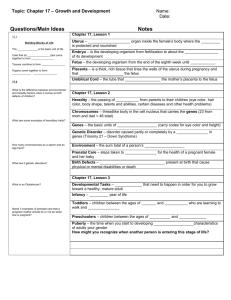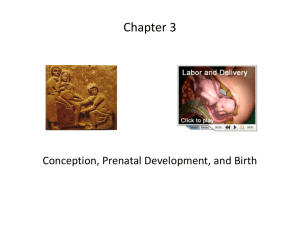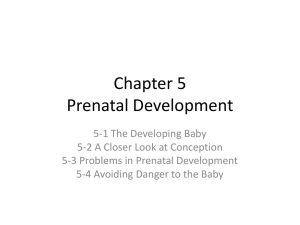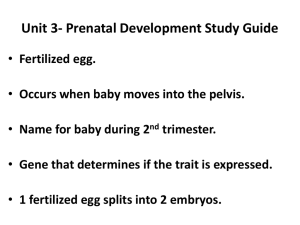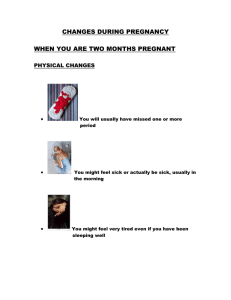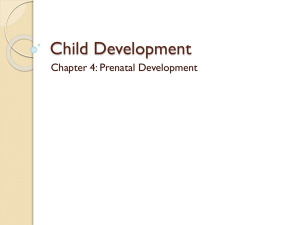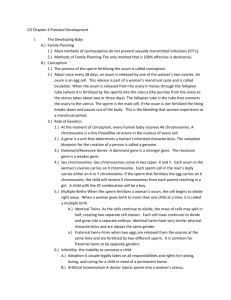Prenatal Development
advertisement
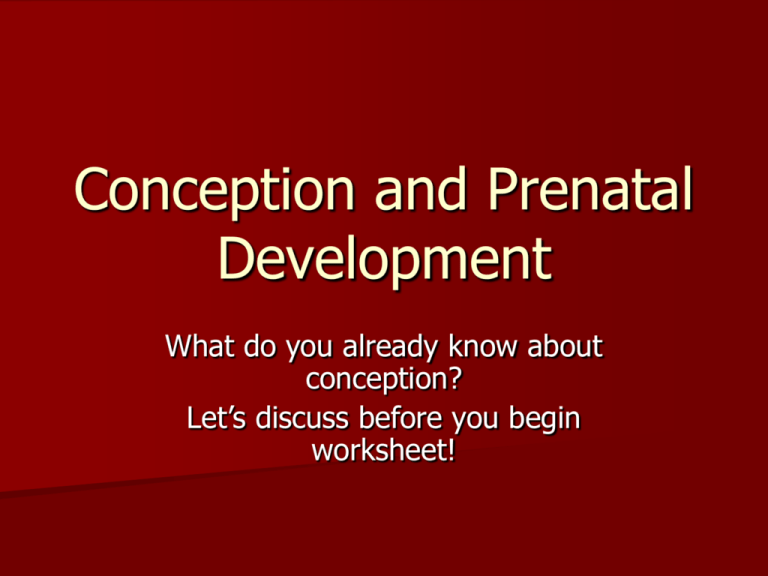
Conception and Prenatal Development What do you already know about conception? Let’s discuss before you begin worksheet! Anatomy Female sex cell called __________. Male sex cell called __________. Ovum is released by the ___________. Ovum travels down the ______________ tube. Sperm travels through the vagina, cervix, up the ___________ to the ___________ where it could ____________ the ovum. Reproductive Systems Male reproductive system Female Reproductive System Movie time… Process of Conception Video http://video.google.com/videoplay?docid= -4530276804858686422 – Conception When the ovum (egg) and sperm unite in the fallopian tube; pregnancy begins. Fertilization can take place only 2-3 days after the ovum is released into the fallopian tube. Sperm can live for up to seven days. Only about 10 days a month can a woman can become pregnant. Contraception A method used to avoid pregnancy – Abstinence – Permanent – Chemical/hormonal methods – Barrier methods – Rhythm method Most do not protect against STD/STI Other forms of fertilization (for Infertility) Artificial insemination – Sperm are injected with a special needle into the uterus. May be from donor or natural father. In Vitro fertilization – Fertilization occurs outside of uterus and zygote are implanted in uterus. – Ovum transfer – egg taken from donor Surrogate mother – Become pregnant for another couple Three stages of baby’s development Zygote/Germinal Embryonic Fetal Zygote/Germinal Stage Lasts about two weeks, when cells duplicate and form into a mass of cells. Zygote travels down the fallopian tube to the uterus. The uterine lining thickens to receive the zygote. After two weeks the zygote is the size of a pinhead. Embryo Stage 3rd – 8th week of development Mass of cells develops into all the major systems of the human body. – All organs are present, but not functioning. – Brain begins to take control of organs. – Drugs, alcohol are dangerous. Sac w/ amniotic fluid begins to surround embryo for protection. http://www.babycenter.com/2_insidepregnancy-weeks-1-to-9_10302602.bc Embryonic Period Placenta (tissue in the uterus that is rich in blood cells) develops. Umbilical cord between baby and mother carries food and oxygen to baby from mother’s blood stream, and takes away waste products. Fetal Alcohol Syndrome (FAS) Baby has smaller head and size for gestational age; thin arms & legs. Flat mid-face and nose bridge; ear and hand anomalies; skin folds on corners of eyes. Thin lips; small lower jaw. Non-visible injuries: – Central nervous system problems. – Learning disabilities – Emotional and behavioral disorders; hyperactivity – Reduced cognitive ability video http://abcnews.go.com/GMA/video/adopti ve-parents-give-child-awat-fasd11734589&tab=9482930&section=120685 2&playlist=11128107 Video of parents who had to give away daughter. Alcohol statistics Among pregnant women, 1 in 10 drink alcohol. Among pregnant women, 1 in 25 binge drink. More than 1 in 5 women drink in first trimester. About 1 in 100 babies are born effected by alcohol exposure. About 1 in 1000 have FAS. Lifetime expense of baby with FAS is approx. $2m After birth, can still be affected through breast feeding.* How drugs affect the Unborn Three ways: – Direct injury – leading to birth defects or death – Constriction of blood vessels in the placenta, reduces oxygen supply & nutrients to fetus, resulting in low birth weight and/or premature birth. – Forceful premature contractions of uterine muscles, reducing blood supply. May trigger premature birth or preterm labor. Life time effects Up to 2 years: – Feeding, Cerebral Palsy, irritability, poor weight gain, tremors, vision problems… Toddler to preschool: – Social interaction, delayed language develop., processing information, hyperactivity… Early school – Teenage years: – Behavioral problems, learning disabilities, neglect and abuse. Drug Exposure More than 90% of pregnant women take or use some type of drug. Between 550,000 – 750,000 infants have been exposed to drugs. 2 – 3 % of birth defects are a result of prenatal drug exposure. No drug should be used without Dr. supervision. Fetal Stage 8th week – birth “Flutter” about 4th-5th month – feeling of first kick. “Quickening” when kicks become more frequent and stronger. 7th month baby can live outside of womb but will need medical care. Fetal Stage 8th -9th month – Organs begin to be ready to function – Moves into head down position – Amniotic fluid decreases – Weight gain continues – Fetus gains fat cells to protect it and keep it warm; Baby’s skin becomes smoother as it fills in. Preparing for birth “Lightening” when baby’s weight shifts down into position. Days to weeks before labor begins. Should be head down. Child will be born 37-42 weeks after conception. Chromosomes Chromosomes contains genetic materials that determine who you are hereditarily 46 total – 23 from egg/ 23 from sperm Dominant genes – stronger gene; characteristics are prominent Recessive genes – weaker gene; characteristic is “carried” but may not be seen. Sex chromosomes – XX is girl/ XY is boy Birth Defects Hereditary or environmental causes Physical or mental May spontaneously abort – miscarriage May have still birth – death of developing baby after 20 weeks Genetic counseling and prenatal testing to have knowledge of defect and how to live with it. Diseases that can cause defects Rubella (German Measles) Blindness, deafness, heart disease, mental delays Vaccine before getting pregnant Toxoplasmosis Blindness, learning disablities, miscarriage, stillbirth Do not clean cat litter; eat uncooked meat; contaminated produce Chicken Pox Skin scarring, limb defects, eye problems, abnormalities, miscarriage. Vaccine before becoming pregnant STDs & AIDS Physical & mental disabilities; death Discuss exposure w/ doctor; get tested; take precautions Prenatal testing Prenatal test Description Risk Alpha-fetoprotein (AFP) (15 – 20 weeks) Blood test No risk to date. Ultrasound (20th week) Sound Waves used to make image of fetus. No risk to date Amniocentesis (16th week) Withdraw amniotic fluid to determine defects Miscarriage Chorionic villi sampling (CVS) (6-10 wks) Take sample of tissue from placenta 10 weeks Miscarriage http://www.babycenter.com/2_inside -pregnancy-labor-andbirth_3658872.bc
